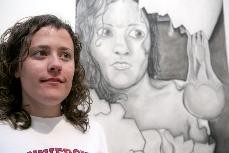A new program model is shaking the foundations of the School of Art.
But this change doesn’t come with the doom-and-gloom predictions other transformations have inspired. Instead of creating limitations, the program is intended to refresh and revitalize the way UA students go about art.
“”It’s like science,”” said art professor Gary Setzer, Foundations program coordinator. “”Science advances every year and you have to change the textbooks.””
The School of Art is making a transition from the principles of design system to a program that will focus more on the basics of contemporary art.
“”So (students are) not making art from the 1950s or 1920s,”” Setzer said. “”They realized it was kind of an outdated system.””
Currently, the School of Art requires three Foundations courses for all studio art majors, which consist of Drawing, Color & Design, and 3D Foundations.
Each class requires a time commitment of six hours weekly, which can be daunting for media arts majors who might not want to focus on drawing in the first place.
“”I had drawn a little bit before and I actually hated it when I first started,”” visual communications freshman Katie Mount said about her first drawing class. “”But I got used to it and I actually really like it now. It’s fun, but it’s also really time-consuming for a class.””
Setzer said that similar sentiments are not uncommon.ÿ
“”Part of the driving force behind the new model of the Foundations program was to combat the longevity of the semester,”” he said. “”It seems sometimes like no amount of variety would be enough to keep some students engaged, for the freshmen especially.””
The updated program aims to break down the elements of design into eight different workshops including Mapping, Space, Gaze, Amalgam, and Propaganda.ÿ
One of the most notable additions to the program is an opportunity forÿstudents interested in photography and media arts to get some experience in their preferred fields right from the start.
The eight-week Gaze workshop is a brief introduction to the world through a photographic lens.
Since the UA is nationally recognized for the Center for Creative Photography and the graduate program, the School of Art administration decided it was important to introduce photography concepts at an early stage in art education.
“”There was concern that we might lose some potential amazing photographers because they had no opportunity up front,”” said Setzer.
Courses in Drawing, Color and Design still play a vital role in photographic and media education, he said.
“”Learning how to draw is the same type of ‘learning how to see’ that you do through a camera, but it’s the analog version of it,”” Setzer said. “”If you can sit down and compose an image with charcoal, it changes the way you look through a camera lens.””
Mount expressed frustration with the introduction of drawing techniques.
“”I had never touched charcoal before in my life, so the first month of that class I was really pissed,”” she said. “”The teacher was like ‘okay here you go,’ and I had to tell her ‘um, I’ve never done this before…'””
For all her trepidation, however, Mount stuck with the class through the end of the semester.
One of her pieces, entitled “”Strange Fear,”” is currently on display in the Lionel Rombach Gallery as part of the second annual Foundations Exhibition. The exhibit showcases student works from each of the three Foundations courses.
According to curator Brooke Grucella, the goal of the show is to “”highlight the visionary force of students who are just beginning their pursuit of a career in the arts.””
Setzer said the showcase displays these beginning pursuits from “”two sides of the same coin.””
The Foundations courses are taught almost exclusively by graduate assistants; first-time teachers who are also taking a new step in their careers as artists and educators.
There is often a stigma associated with graduate instructors, Setzer said.
“”Oftentimes the student feels like a guinea pig,”” he said. “”This new teacher is learning how to teach, and the student is at the other end of that.””
While it requires some adjustment of expectations, the exchange of information can also be a good thing, Setzer said.
“”It’s about being in the room with a mentor, with an artist who’s in it for the first time in a very real way,”” he said.
Setzer is hopeful that the new Foundations format will further inspire this visionary force of new artists. “”It’s a philosophical shift,”” he says. “”Some of that inspiration transmits from seeing the instructor pick up the materials and do.””









